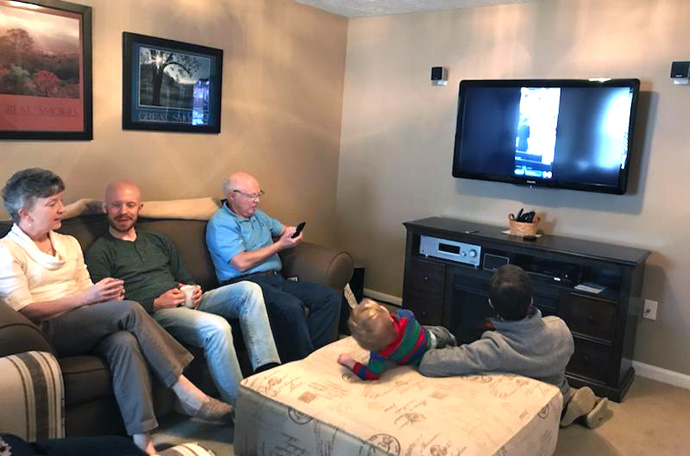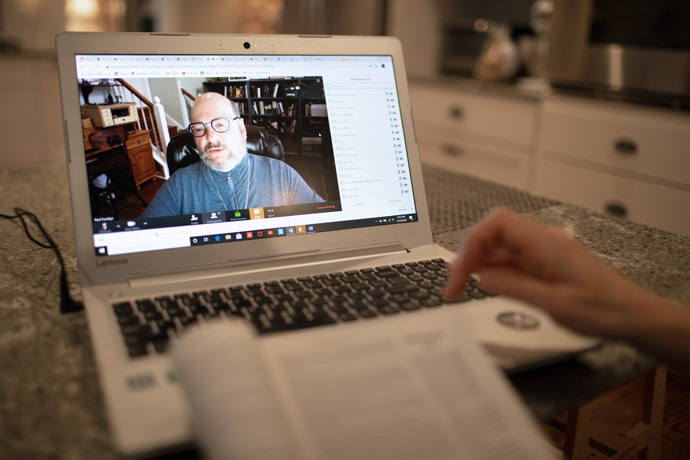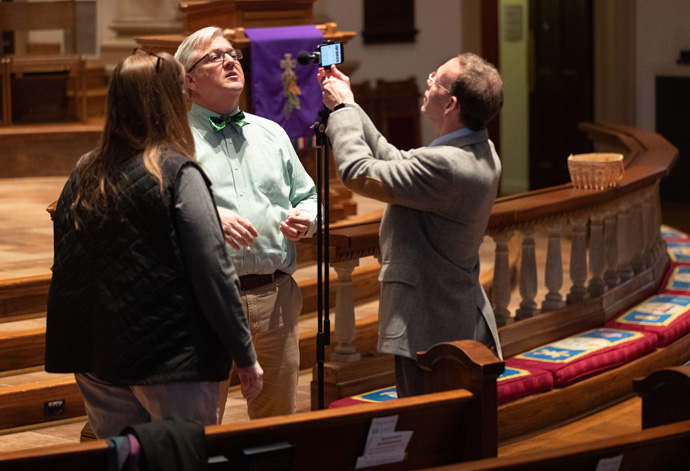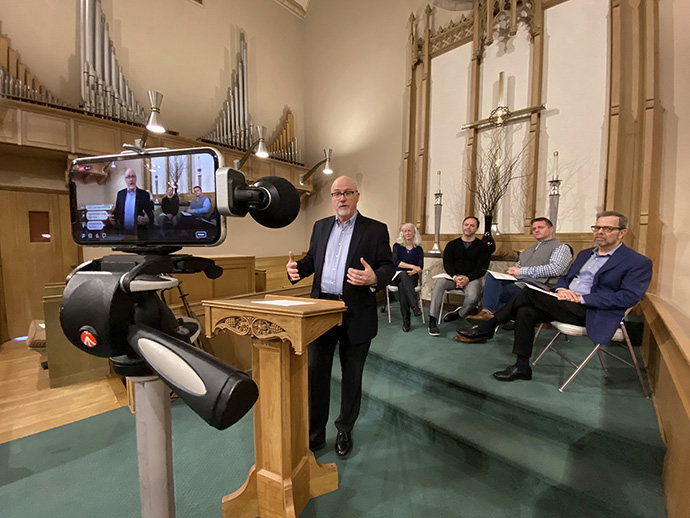From a kitchen island to a comfy sofa, in pajamas or a T-shirt, on a laptop or a mobile phone — a number of United Methodists went to church online this past Sunday, some of them for the first time.
Whether by suggestion or mandatory decree, churches around the U.S. began to adjust March 15 to what it means to be a worshipping community during the coronavirus outbreak.
“We want them to be in relationship with one another even if that’s through technology,” said the Rev. Patty Groot, a minister at Christ Church United Methodist in Louisville.
Christ Church, one of the largest congregations in the Kentucky Conference, planned a livestream of its usual 11:15 a.m. service after Bishop Leonard Fairley and his cabinet asked that all churches in the conference cancel gatherings at their church building.
So many churches were doing the same thing that the streaming service the church uses crashed. Kim Keller, the church’s communications director, was ready with an alternative plan and with her technical crew switched the feed to Facebook Live.

Belmont United Methodist Church in Nashville, Tennessee, already has been offering livestreamed worship, but tried to make the March 15 services “a little more intentional” toward the larger congregation watching from home, said the Rev. Paul Purdue, senior pastor.
Church members were encouraged to stay home, but those who felt the need for sacred space also were welcome to come and practice social distancing. There was plenty of room for that in the 650-seat sanctuary — Purdue said he counted 6 at the 8:30 a.m. and 26 at the 10:30 a.m. services, in addition to those leading worship.
The services drew about 75 comments on Facebook by Sunday night, accompanied by some pictures of families watching in slippers and PJs. In fact, the early service proved more popular. “I think a lot of folks thought ‘I’m going to eat breakfast and then I’m going to worship,’” Purdue noted.
A longtime Sunday school class at Belmont also decided to meet online. Paul Franklyn, a biblical scholar who co-teaches the lectionary-based Friendship Class, said the study group’s natural rapport helped make that a success. When his spouse, Mary Beth Franklyn, discussed two icons that pertain to the weekly texts, “we were able to share the screen with the group in a way you really can’t do in a physical classroom,” he added.
However, Franklyn believes it is a challenge to maintaining long-term participation through virtual gatherings. “People can check out pretty quick,” he said.

To draw in congregants March 15, churches broadcast on a range of platforms, from website live streaming to Facebook to YouTube. Churches also used a variety of musical offerings.
Some big churches, such as Highland Park United Methodist in Dallas and St. Luke’s United Methodist in Oklahoma, brought in their chancel choirs. Others had praise bands or single or duo instrumentalists.
Churches adapted in other ways, such as offering links to register attendance and creating PDF files of bulletins so people at home could follow the liturgy.
Hyde Park United Methodist in Tampa, Florida, solicited online requests for pastoral care:
“Are you sick or in quarantine? We want to make sure that our community remains connected, even when illness or quarantine requires physical separation. Please complete this form so we are aware of your circumstances.”
A primer for online worship
Read Resource UMC article.
The Rev. Stephanie Ahlschwede of St. Paul Benson United Methodist Church, in Omaha, Nebraska, took an unusual approach, offering a 23-minute YouTube video that included her message and piano music.
“I’d like to welcome you to our St. Paul fireside chat,” she began with a broad smile. “Only it’s more of a piano chat and I am not Franklin Roosevelt.”
Some not-yet-tech-savvy churches had to forego worship altogether. That was the case at Divine Street United Methodist in Dunn, North Carolina, where the computers are dated and other necessary equipment for going online is missing altogether.
“For us in this faith community, the hard news is that worship is cancelled for the foreseeable future,” said the Rev. Elizabeth Ann Gaines, pastor.
Gaines hopes to compensate in various ways, including stepping up her blogging. Her March 16 post addressed the anguish of not being able to gather:
“Staying away from church? Ridiculous. No worship on Easter? Unthinkable? Yet, here we are, facing the ridiculous and unthinkable.”

At Mt. Vernon Place United Methodist Church in Washington, the Rev. Donna Claycomb Sokol also addressed the unthinkable as she stood in an empty sanctuary and spoke into an iPhone.
“Social distancing, those words are the antithesis to Christian community,” she said to those watching on Facebook Live. “Christian community is about spending life together.”
A video story by Drea Cornejo of The Washington Post pointed to the isolating reality of the coronavirus crisis: Claycomb Sokol’s hope that she could convey through a computer screen “that someone is still with you” and members of her congregation taking solace in her words.
Breese Eddy and her two small children sat on their sofa and watched the service on her laptop. “The coronavirus, I think, is making everyone rethink stuff we took for granted — being able to hug, shake hello, share a meal,” she told The Post. “And while it’s a sacrifice, it’s absolutely 100 percent a sacrifice worth making.”
While she is not in the category at greatest risk from COVID-19, Eddy said she feels responsible for the well-being of others. “That means attending church virtually and not being able to join in person.”
Bill Hillegeist, an older Mount Vernon congregant, also supports social distancing. “It’s certainly made worship a more solitary experience,” he said, watching on his phone while at his kitchen island. “I’m denied the physical presence of community and friends surrounding me, the sharing of the handshakes of peace.
“However, I consider this all temporary and it’s something we need to do for the greater good.
“It’s just a necessary evil, because I firmly believe that lowering the (coronavirus) incident rate is truly important. Flattening that curve is the one piece of information that I have taken to heart.”

Bloom is the assistant news editor and Sam Hodges is a Dallas-based reporter for United Methodist News. Cathy Bruce, Associate Director of Connectional Ministries for Communications for the Kentucky Conference, contributed to this report.
Contact Bloom and Hodges at 615-742-5470 or newsdesk@umcom.org. To read more United Methodist news, subscribe to the free daily or weekly digests.
Like what you're reading? Support the ministry of UM News! Your support ensures the latest denominational news, dynamic stories and informative articles will continue to connect our global community. Make a tax-deductible donation at ResourceUMC.org/GiveUMCom.




